If we study the memorials within St Nicholas’ we find that not only do they tell us of the many people associated with the church, they also allow us the occasional glimpse into the social history of the community. The memorials shown here are only a small number of those which can be viewed around the church, but they do illustrate that not only the great and good, but the ordinary person, is remembered at St Nicholas’.
Click on the images to open a large version in a new window. Click again on image to further enlarge.
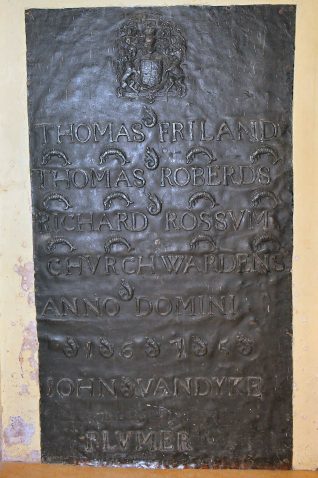
Lead memorials 1665

Lead memorials 1705
Memorials on lead roofing
The two memorials above are in fact sheets of lead. It is believed that they were found in the roof of St Nicholas at the time of the restoration in the 19th century. The first, dated 1675, contains the names of three churchwardens of the time and finally, almost as a postscript is added ‘John Vandyke’ who was a ‘Plumer’. How wonderful that an ordinary jobbing plumber signifies a link across over three hundred years, with visitors who view that memorial today.
Dolphins and Brighton
The memorial also contains images of dolphins, which of course now form part of the coat of arms of our city. Often referred to as ‘The Sailor’s Friend’, dolphins were judged from ancient times to be intelligent, skilful and devoted to saving lives. Early Christians began to use the image of the dolphin as a specific symbol of Christ, the ‘guide’ of souls across the waters of death. The second memorial is dated 1705, and it is probable that it was part of the roof which was completely destroyed in the great storm of that year.
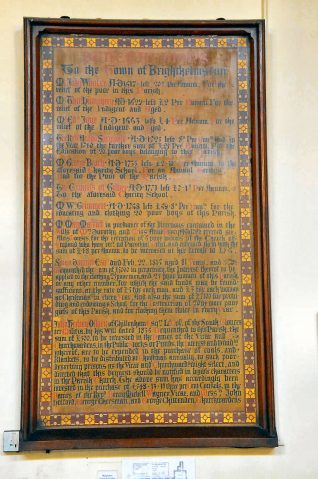
List of church benefactors

Memorial to Henry Michell Wagner 1792-1870
Benefactor bequests
The list of church benefactors above shows how those who worshipped at St Nicholas’ remembered the poor and needy of the parish in their wills. The bequests range from 20 shillings per annum for the poor, left by Mr John Woolfe who died in 1617, to two very large bequests by Dr Swan Downer, a rich London trader who died in 1816. Swan Downer was a native of Brighton and in his will bequeathed the sum of £12,100; £7,100 was to be invested in Government Securities for the endowment of a charity school for girls and a further £5,000 to clothe 24 poor men and 24 poor women of Brighton.
Henry Michell Wagner
In 1824, Henry Mitchell Wagner was appointed Vicar of Brighton at St Nicholas Church, a post he held until his death in 1870. His grandfather, Henry Michell, had been Vicar of Brighton at St Nicholas for 45 years from 1744 to 1789. You can read about Henry Michell Wagner and his time at St Nicholas’ Church here.

Richard Cromwell Carpenter 1812-1855
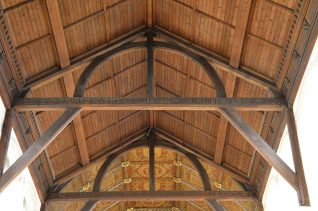
Somers Clarke Jnr 1841-1926
Richard Cromwell Carpenter
Richard Cromwell Carpenter (1812 –1855) is chiefly remembered as an ecclesiastical architect who was a member of the Cambridge Movement. Known as ‘tractarians’, the members were devoted to the return of medieval forms of liturgy and church building within the Church of England. Carpenter was the architect responsible for the 1853 restoration of St Nicholas’. The brass plaque commemorating his work is built into the step between the Chancel and the Lady Chapel, perhaps a somewhat inauspicious placing for a memorial to a man who worked so hard for the church. Sadly, Carpenter died of tuberculosis at the age of 42 years, just one year after the completion of the church restoration.
Somers Clarke Junior
Somers Clarke Junior was born in Brighton in 1841; as an architect he was articled to Sir Gilbert Scott. He was the son of a solicitor and clerk to the vestry of Brighton of the same name, hence the ‘Junior’. Somers Clark Senior was vestry clerk from 1830 until his death in 1892 at 89 years old. Somers Clark Junior was responsible for various restorations at St Nicholas; most notably he supervised raising St Nicholas’ roof to allow clerestory windows to be added. His finest work is probably St. Martin’s Church, Lewes Road, Brighton (1875)
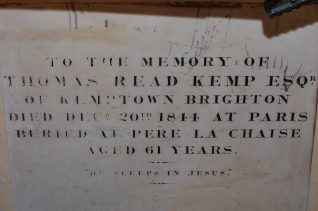
Thomas Kemp 1782-1844
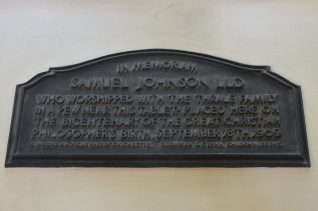
Dr Samuel Johnson 1709-1784
Thomas Read Kemp
Thomas Read Kemp was born on 23 December 1782 at Lewes, the son of Thomas Kemp. T.R.Kemp graduated in theology at Cambridge in 1805; in 1811 he succeeded to his late father’s moiety of the Manor of Brighton, and also became Member of Parliament for Lewes. In 1816 he resigned his seat and founded a dissenting religious sect, preaching in Brighton for six years. By 1823 he had returned to politics and also the established church. It was at this time that he conceived the notion of the fashionable estate in Brighton that was to bear his name. Kemp was very prominent in local affairs as he was lord of the manor, an ex-officio town commissioner until 1825 and a magistrate; his generosity in gifts of land for worthy causes such as schools and hospitals is particularly noteworthy. After initial success his property scheme failed, and Kemp was forced to flee to Paris to escape his creditors; he died there in December 1844.
Dr Samuel Johnson
Samuel Johnson made lasting contributions to English literature as a poet, essayist, moralist, literary critic, biographer, editor and lexicographer; Johnson was a devout Anglican. Dr Johnson’s A Dictionary of the English Language was published in 1755. It had a far-reaching effect on Modern English and has been described as one of the greatest single achievements of scholarship. Johnson was a regular worshipper at St Nicholas’ in the 1770s, when he visited the house of Henry and Hester Thrale. The Thrale family, owners of London’s Anchor Brewery, played host to many literary guests in the late eighteenth century in their house in West Street.




No Comments
Add a comment about this page